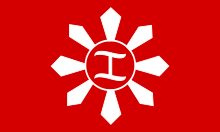Baybayin


Baybayin (traditional Baybayin: ᜊᜊᜌᜒ / colonial Baybayin: ᜊᜌ᜔ᜊᜌᜒᜈ᜔ ) (also called Alibata ) is a pre-colonial script that was used exclusively on the Philippine island of Luzon in the Middle Ages . The syllabic-alphabetical system derived from the Javanese Kawi script was used for Tagalog , Ilokano and Pangasinan . The Baybayin already existed in the 12th century and continued to be used until the early days of the Spanish colonization of the Philippines . Baybayin literally means "spelling". The scripts Hanunó'o , Buhid and Tagbanwa of the Filipino hill tribe, which are still in use today , are similar to the Baybayin. The Baybayin font is part of the Unicode standard and is called the Tagalog font there ( Unicode block Tagalog ).
It is an Abugida script, in which every character in its basic form is a consonant that ends with the vowel "a". To produce consonants with other vowels, a character is added either above (to produce “e” or “i”) or below (to produce “o” or “u”) the character. This character is called kudlit and is not used for vowels that have their own characters.
The following table shows the characters of Baybayin, using Unicode , as well as their translation into the Philippine alphabet and into the IPA .
|
Vowels
|
b
|
k
|
d or r
|
G
|
H
|
l
|
m
|
n
|
ng
|
p
|
s
|
t
|
w
|
y
|
Baybayin from the Spanish colonial days until today
The Baybayin script was used for Catholic missionary work in the Spanish colonial times of the Philippines. In 1593 the Doctrina Christiana, en lengua española y tagala appeared as one of the first Christian books on Baybayin. As the book was printed bilingual in Spanish and Tagalog , there is a very rare glimpse into the Tagalog language before it was influenced by Spanish.
Since Baybayin could not produce consonants without vowels, Spanish priests added an additional kudlit to the script, which, as a reference to Christianity, resembles a "+" in order to omit the vowel entirely. This kudlit works just like the virama in the Indian Devanagari script .
Baybayin disappeared noticeably in the 17th century, although until the 18th century Baybayin was still signed and poems were written with it. The mountain people of Mindoro never stopped using a similar script to this day. Today the Philippines is largely written using the Latin alphabet. In the wake of nationalistic tendencies of the last decades, however, Baybayin has become popular again in the Philippines.
Vases from the 12th century in Japan indicate trade between Luzon and Japan. The so-called Rusun-Tsukuri (Japanese: 呂宋 製 or 呂宋 つ く り) (literally: "Made in Luzon" or "Made in Luzon") were decorated with Baybayin by the respective manufacturers. These decorations indicate the original content of the vases as well as the manufacturer. Most often there was green tea or rice wine in them. The only factory from this period that still exists today comes from Burnay Ilocos and makes vases.
Baybayin on the Philippine banknotes
Since the currency reform in 2010, the word "Pilipino" (Baybayin: ᜉᜒᜎᜒᜉᜒᜈᜓ), in English: Filipino, has been found on the bottom right of every banknote in the Philippines . The font used is the PC font developed by Paul Morrow.
swell
- ↑ http://sambali.blogspot.com/2006/09/luzon-jars-glossary.html
- ↑ Archive link ( Memento of the original from October 19, 2014 in the Internet Archive ) Info: The archive link was inserted automatically and has not yet been checked. Please check the original and archive link according to the instructions and then remove this notice.
- ↑ http://blog.baybayin.com/2010/12/16/the-man-behind-the-baybayin-on-the-new-peso-bills/


